No need to decide between carrot cake and oatmeal cookies! These are an inspired mash-up of these two beloved classics. Super simple to make, too. The shredded carrots add color and moisture to what is a fairly traditional oatmeal cookie recipe. We have raisins and walnuts added, in addition to unsweetened coconut. Make sure to use unsweetened coconut, because sweetened will put the cookies way over the top in sweetness level.
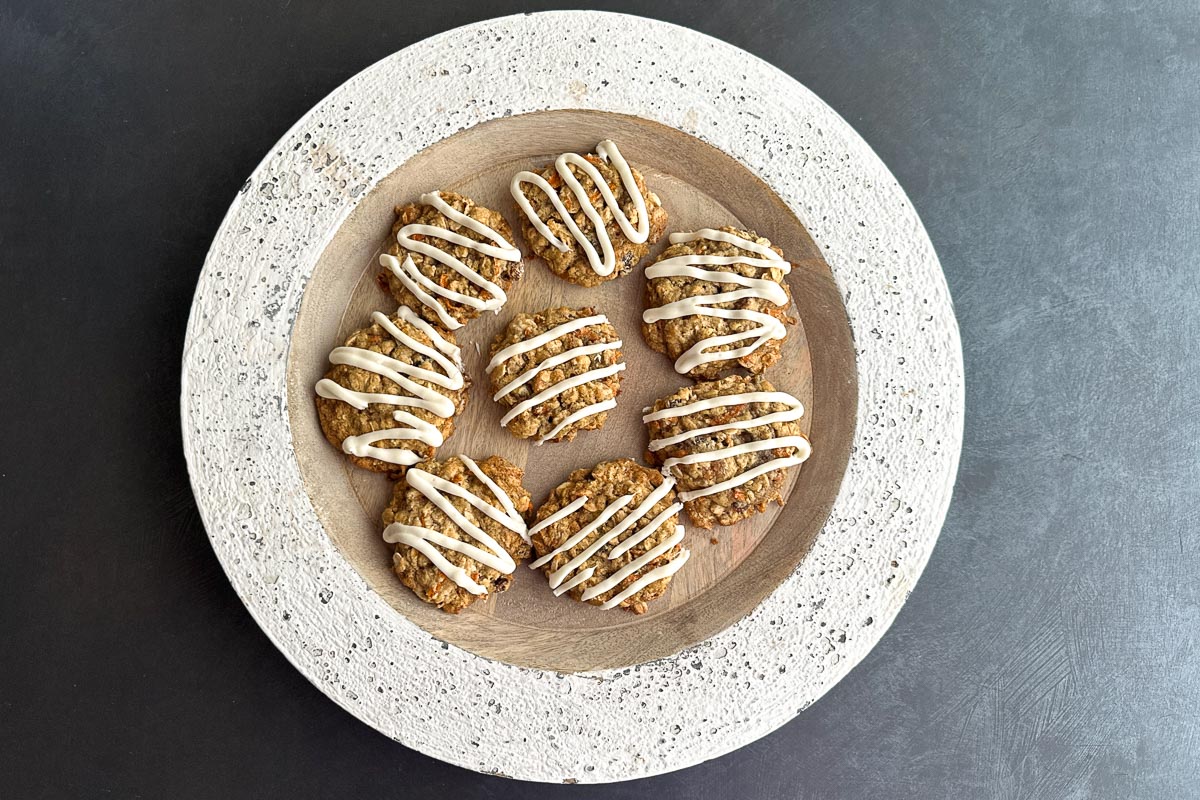
The cream cheese drizzle is truly not necessary. These cookies are delectable without it, but if you take the time to make it, people will be extra thrilled.
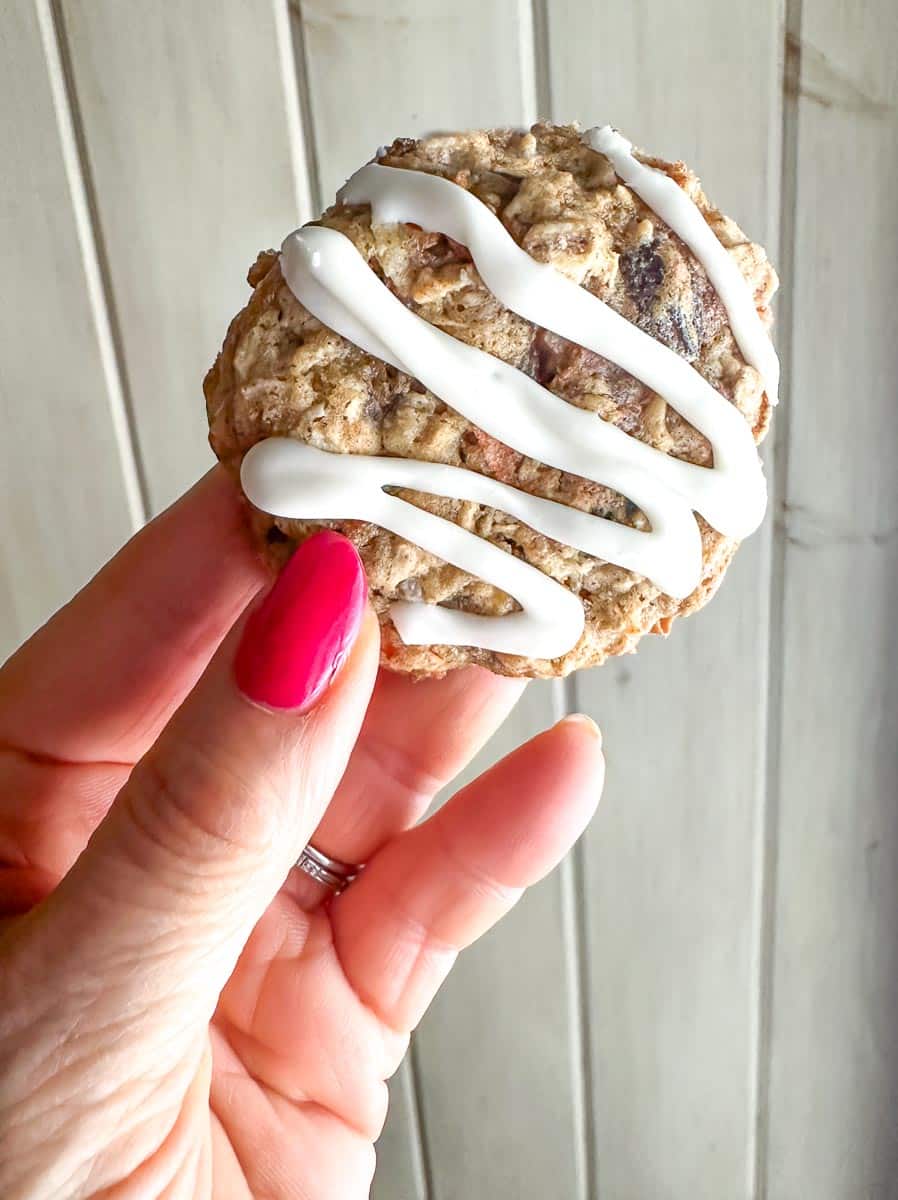
Frequently Asked Questions
Hopefully you are aware that the low FODMAP diet is not dairy free, and it is not lactose free either. It is lower in lactose. 40 g of conventional Cream cheese, which is about two Australian tablespoons, is low FODMAP. That is the entire amount used in this recipe and the batch of drizzle is divided amongst two dozen cookies.
This recipe for Low FODMAP Carrot Cake Oatmeal Cookies with Cream Cheese Drizzle uses coconut oil as the fat. You could use another vegetable oil, such as canola, but why give up a chance to impart more coconut flavor?
But you have you know what kind of coconut oil to buy. There is refined and unrefined.
Here’s what you should tuck away as helpful info:
– Unrefined coconut oil does have a coconut flavor. We use it in recipes such as this one, where we want to accentuate coconut flavor.
– Refined coconut oil does not have any coconut flavor.
– Both unrefined and refined coconut oil are low FODMAP; all pure fats contain no FODMAPs.
– They can be used interchangeably in recipes. Simply use the same amount, but the dish’s flavor will be affected.
As far as the unsweetened coconut is concerned, yes, dried coconut has low FODMAP serving sizes. More detailed info below under FODMAP Information, and read our deep-dive article, Is Coconut Low FODMAP?
Yes, raisins have a low FODMAP serving size. Raisins: Monash and FODMAP Friendly have both lab tested raisins. While raw grapes contain no FODMAPs, the natural sugars concentrate upon drying and the resulting raisins do contain FODMAPs. Monash says a low FODMAP Green Light serving is 1 Australian tablespoon (13 g). FODMAP Friendly gives them a “Pass” at 3 tablespoons (30 g); they set a max serve at 13 tablespoons (130 g).
Variations
You can leave out the raisins, and/or the nuts. Your cookie yield will change slightly. Please do not leave out the coconut, as it adds texture to this recipe that makes it work as well as it does. You could try leaving it out, if you must, but I cannot guarantee success. DO make sure you use unsweetened coconut!
Make The Cookies!
For the Cookies: In a small bowl, whisk together flour, baking soda, and salt; set aside.
In a large mixing bowl, whisk together the oil, sugars, vanilla, and cinnamon…
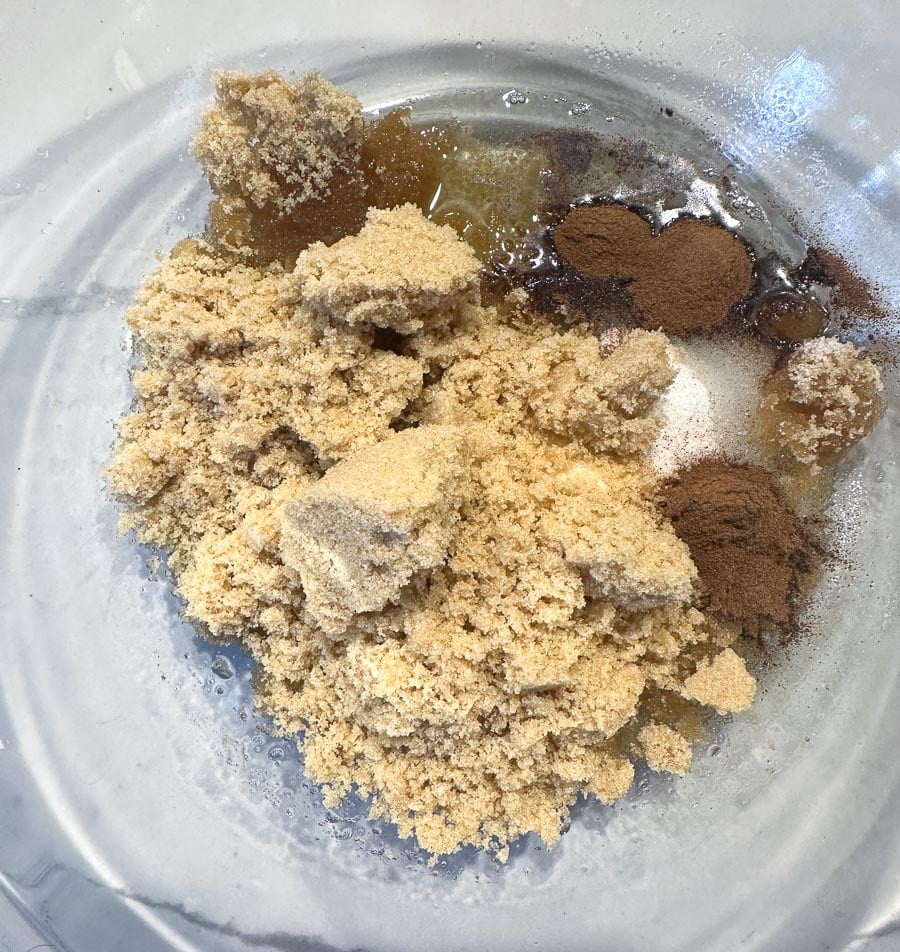
…then whisk in egg.
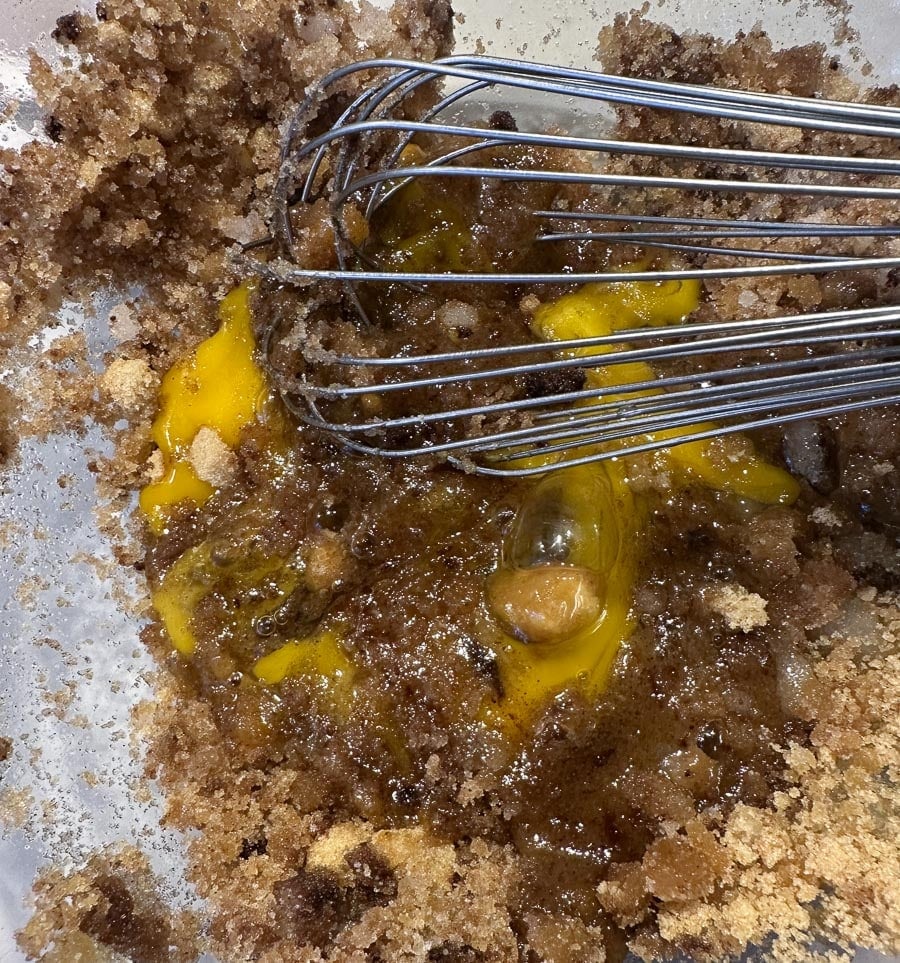
Add the shredded carrots, oats, coconut, raisins and nuts, mixing until combined.
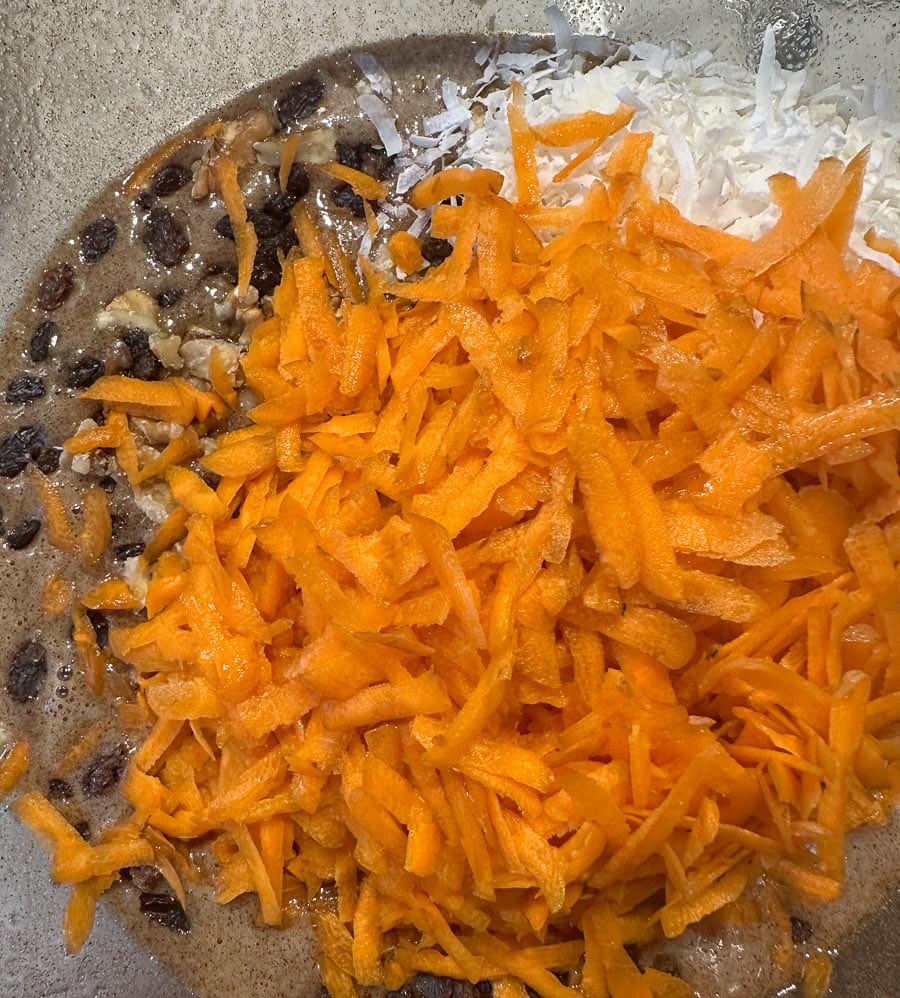
Slowly add flour mixture until cookie dough comes together.
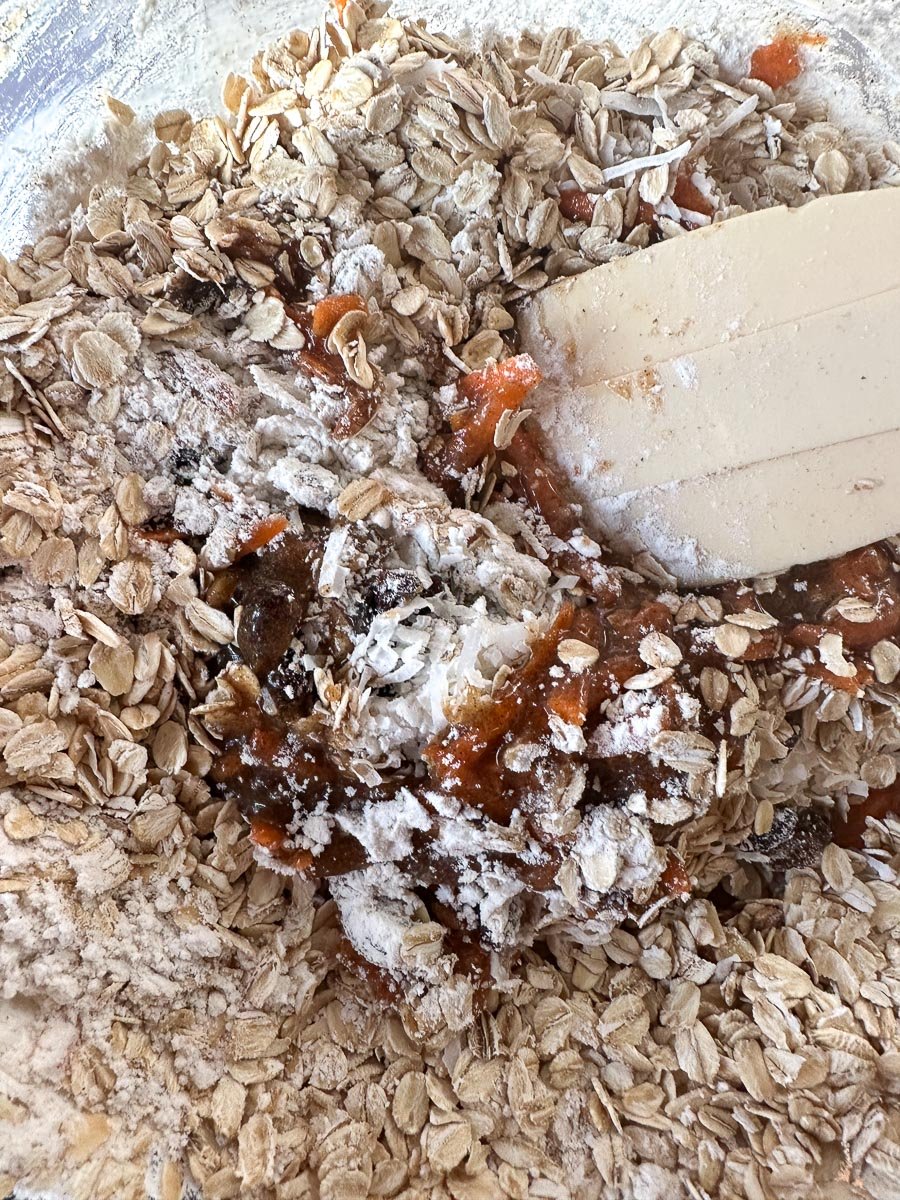
It will be thick; I use a combo of a wooden spoon and a large, sturdy silicone spatula throughout.
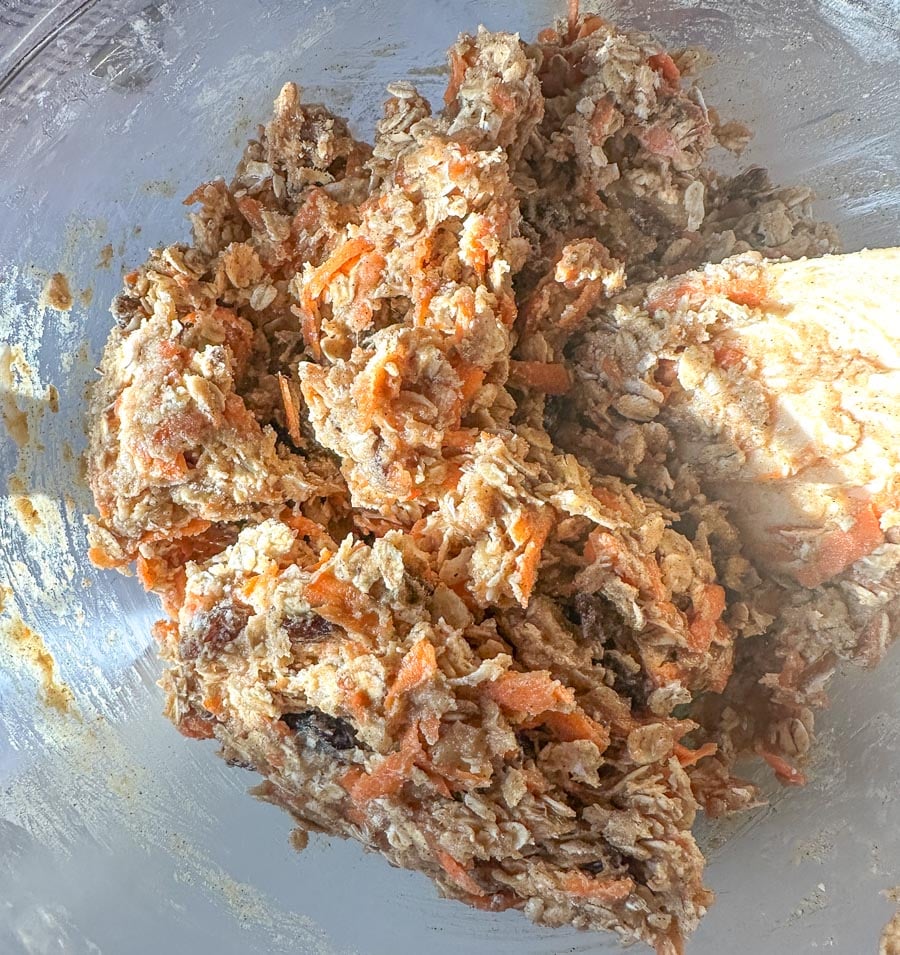
Drop cookie dough in golf-ball sized rounds, 2-inches (5 cm) apart, onto prepared pans.
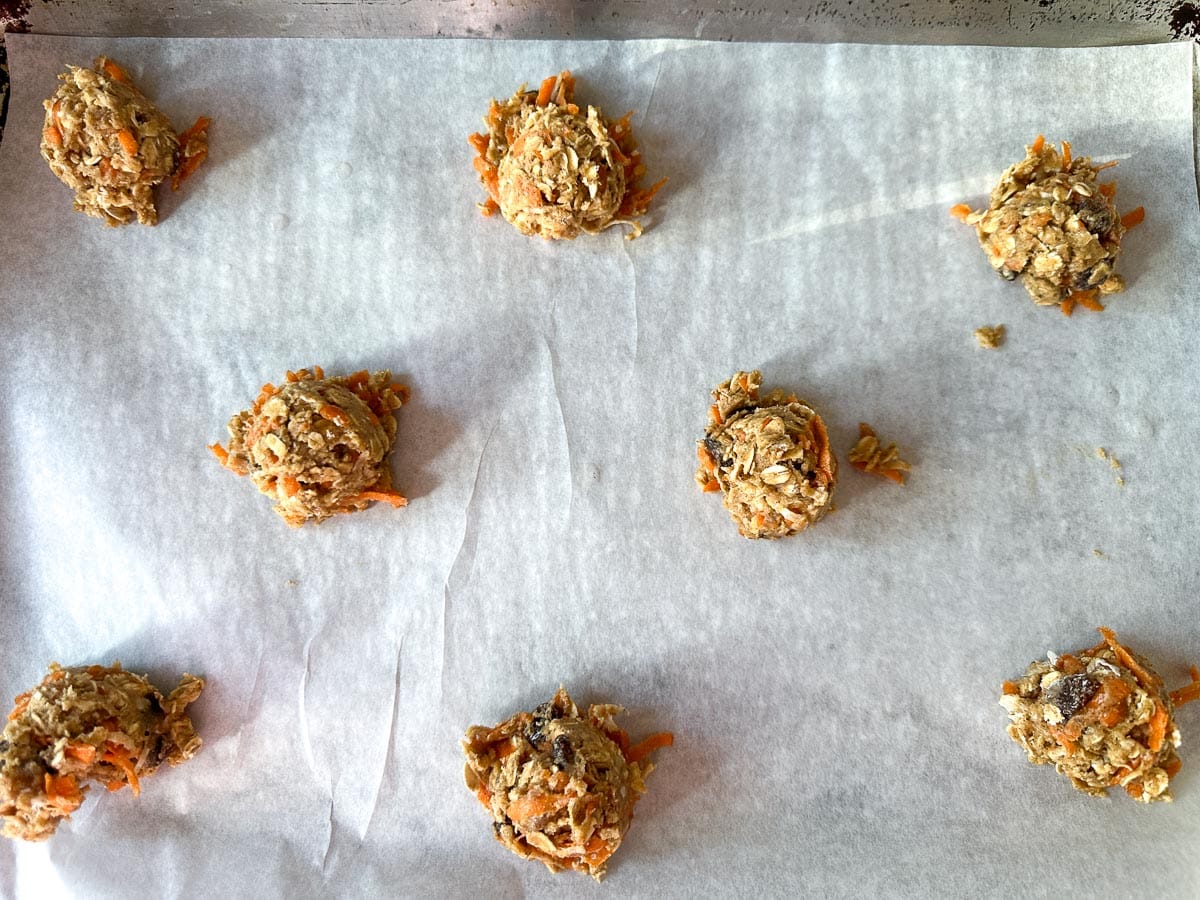
Bake for about 10 to12 minutes, rotating pans from one rack to the other, and front to back, halfway through baking time. Cookies should just be beginning to take on a golden hue, with the edges firmer than the centers; the centers can remain a tad soft. Cool cookies on pans on wire racks.
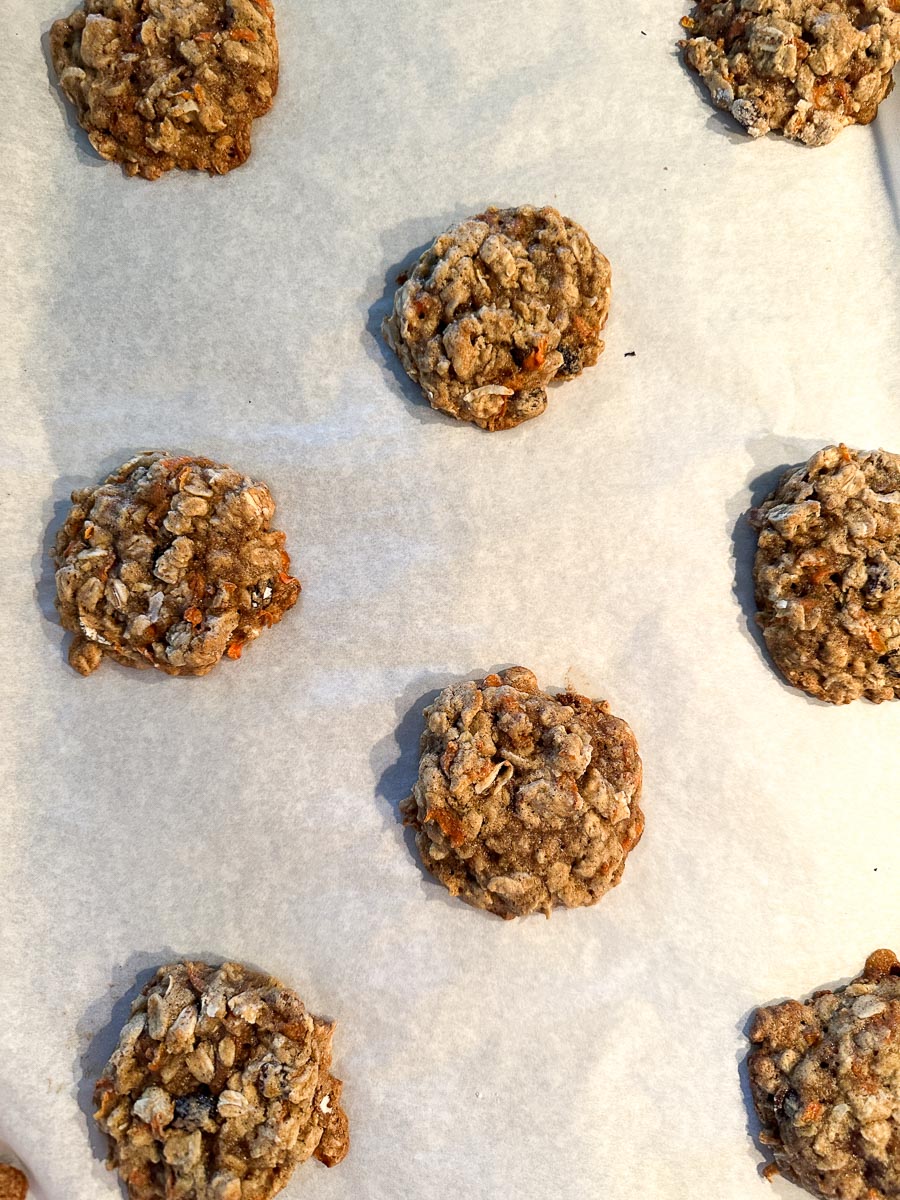
For the Drizzle: While the cookies are cooling, place cream cheese, confectioners’ sugar, milk, and vanilla in a medium bowl.
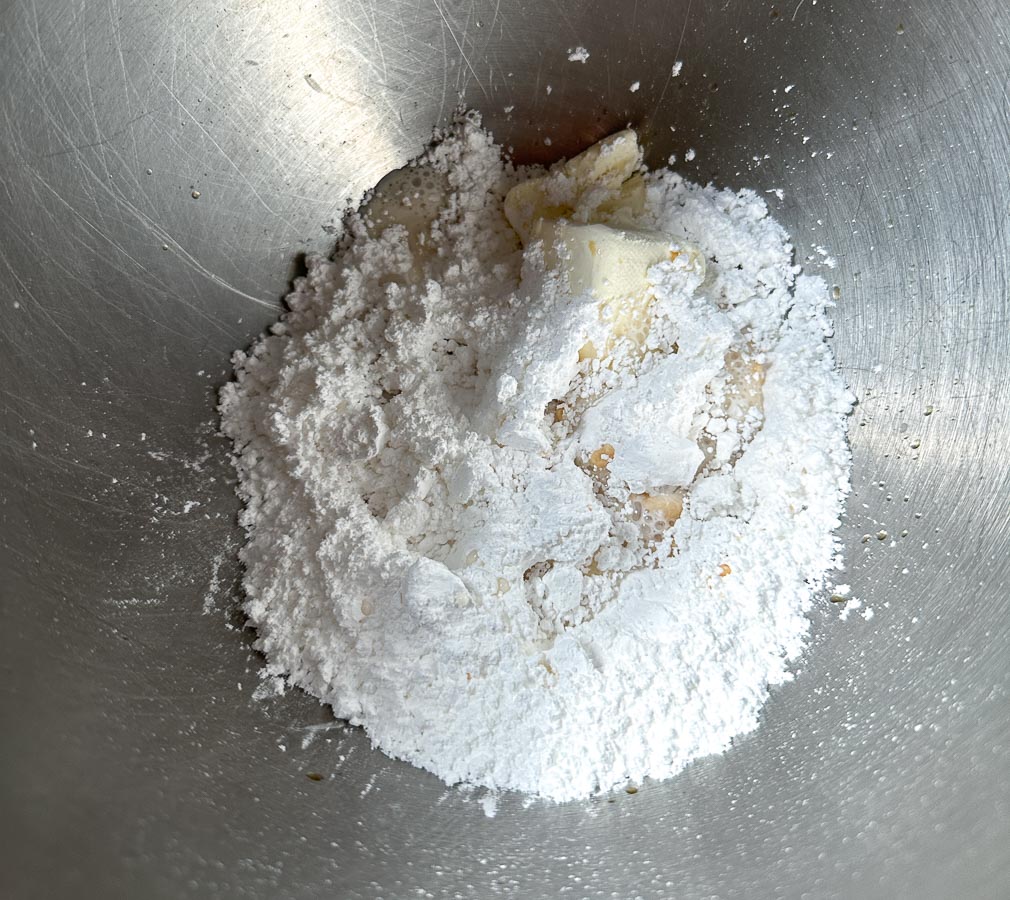
Beat vigorously with a wooden spoon, switching to a whisk, until super smooth and thick, but flowable. Add more milk if necessary. You can drizzle the mixture over the cookies using a fork or spoon, but I like to pipe out of a parchment cone.
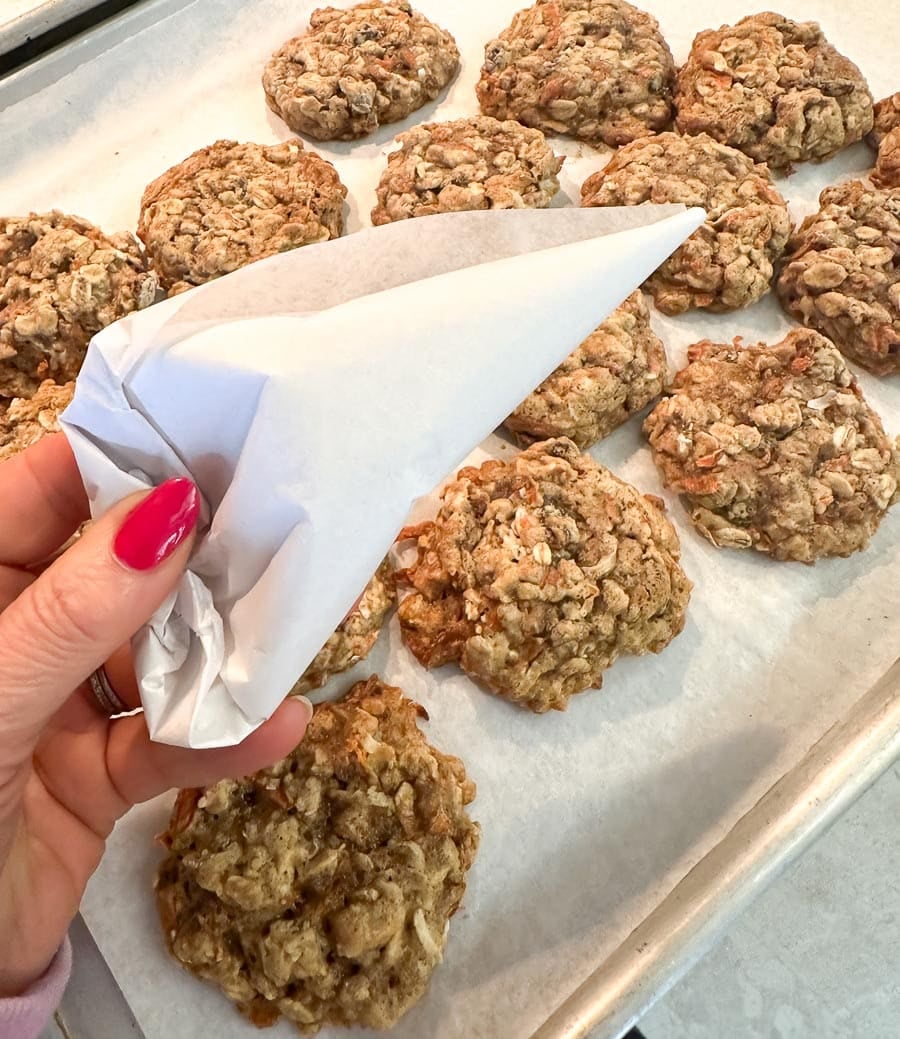
Allow drizzle to set for about 30 minutes; it will firm up.
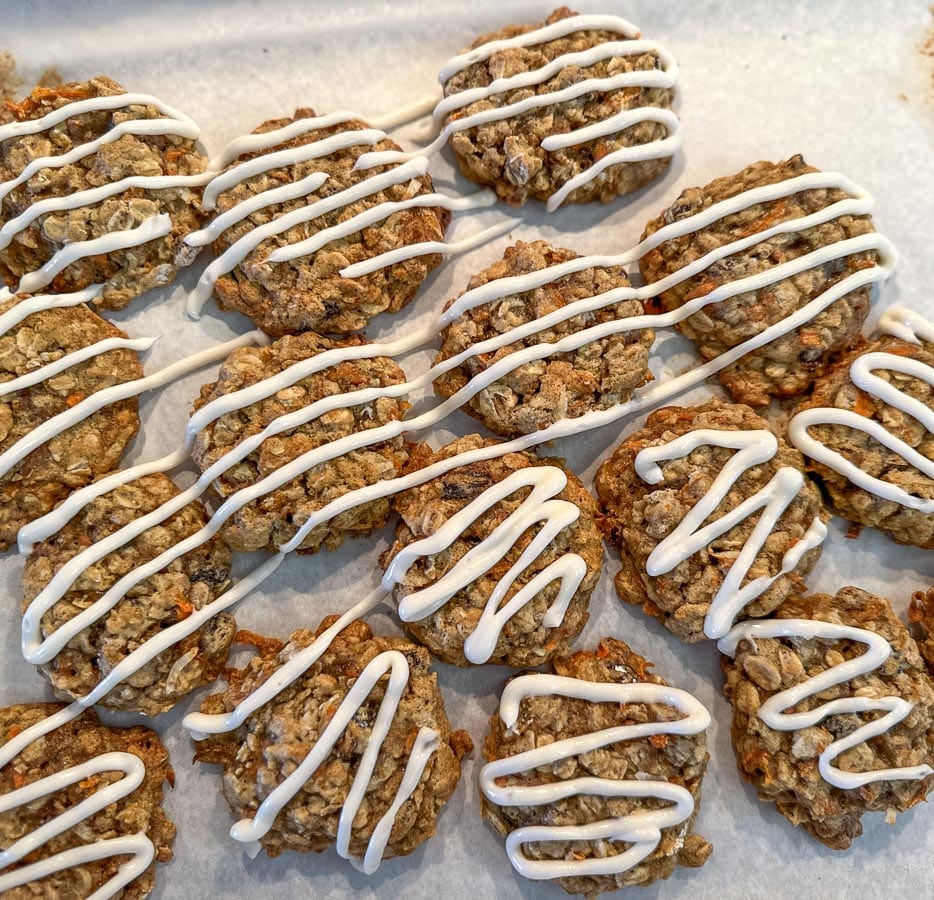
Cookies are ready to serve. Cookies may be stored in single layers, separated by parchment paper, in an airtight container at room temperature for up to 3 days.
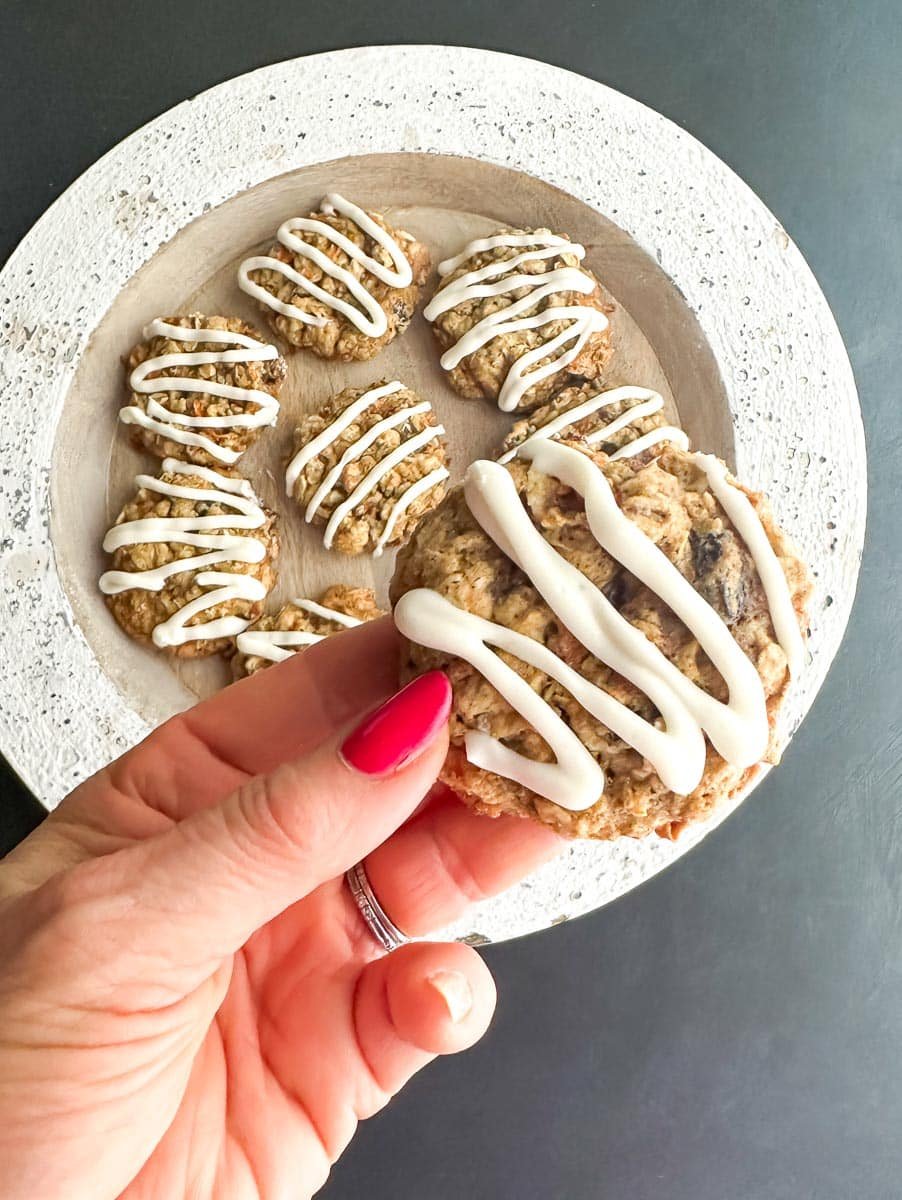
FODMAP Information
All recipes are based upon Monash University & FODMAP Friendly science at time of initial publication.
- Brown Sugar: Brown sugar has been lab tested by both Monash University and FODMAP Friendly. There are many kinds of brown sugar, from cane to beet (to blends) to Muscovado and more, which we discuss in our Explore An Ingredient: Sugar. Unfortunately, there is no information about what kind of brown sugars were lab tested. Monash gives us a low FODMAP amount of ¼ cup or 40 g but no further information. In addition, in private correspondence with Monash University we know that there are amounts larger than 40 g that would be considered low FODMAP. FODMAP Friendly gives us a low FODMAP amount of 13 g. Dark brown Muscovado sugar does appear in a product lab tested and certified low FODMAP by FODMAP Friendly, so we do know there is a low FODMAP amount.
- Carrots: Carrots have been lab tested and deemed low FODMAP by both Monash University and FODMAP Friendly. According to lab tests by both, carrots have shown no FODMAPs. Carrots were retested by Monash and their app entry is unclear. They state that carrots remain low FODMAP up to 500 g, which is a lot of carrot. But they do not give any information about what FODMAP(s) appear at that point in time.
- Coconut, dried: Dried coconut has been lab tested by both Monash University as well as FODMAP Friendly. Monash University lab testing sets a low FODMAP serving at ½ cup (30 g), with it becoming Moderate for FODMAPs at 45 g, and High at 50 g. FODMAP Friendly lab testing sets a low FODMAP serving at ¼ cup (25 g), with a max low FODMAP serve of 1 ¼ cups (125 g). We suggest that you use weights.
- Dairy: The low FODMAP diet is not a dairy-free diet. It is, however, low in lactose. Many dairy ingredients are low in lactose, such as heavy cream and many cheeses.
- Eggs: Eggs are high in protein and do not contain carbohydrates, according to Monash University.
- Oats: Both Monash and FODMAP Friendly have lab tested oats. FODMAP Friendly gave rolled oats a “Pass” at ½ cup or 43 g servings; in an update to the app, they report Quick Oats as low FODMAP at 47 g, or ½ cup uncooked. Their max low FODMAP serving is 59.53 g. Monash has several app entries and some are country specific. Here we present their “basic” app entries which are not country specific (use your app to look up the other entries). For their main entry called “rolled oats” they say a Green Light low FODMAP serving is ½ cup, which they peg at 52 g. For “quick oats” they state that a low FODMAP serving is only ¼ cup at 23 g, becoming moderate Yellow Light at ½ cup or 47 g.
- Oil: All pure oils are fats and contain no carbohydrates, therefore they contain no FODMAPs.
- Raisins: Monash and FODMAP Friendly have both lab tested raisins. While raw grapes contain no FODMAPs, the natural sugars concentrate upon drying and the resulting raisins do contain FODMAPs. Monash says a low FODMAP Green Light serving is 1 Australian tablespoon (13 g). FODMAP Friendly gives them a “Pass” at 3 tablespoons (30 g).
- Spices: Many fresh and dried spice have been lab tested by both Monash University and FODMAP Friendly and are easily looked up in the apps, which we strongly suggest that you have. The additional good news is that if you are interested in a spice that has not been lab tested, you can look at the nutritional panel and assess its FODMAP load for yourself. If the “Sugars” and/or “Carbs” are 1 g or less per serving, then the item would be a good bet to try.
- Sugar: Monash University and FODMAP Friendly have both lab tested white, granulated sugar. Monash states that a Green Light low FODMAP serving size of white sugar is ¼ cup (50 g). FODMAP Friendly simply states that they have tested 1 tablespoon and that it is low FODMAP. Regular granulated white sugar is sucrose, which is a disaccharide made up of equal parts glucose and fructose. Sucrose is broken down and absorbed efficiently in the small intestine. As the fructose is never in excess of the glucose, white sugar will never be high FODMAP, even in large amounts.
- Walnuts: Both Monash University and FODMAP Friendly have lab tested walnuts. FODMAP Friendly gives them a “Pass” at ¼ cup (30 g) portions. Monash lists the same gram amount as low FODMAP and pegs the volume at 10 walnut halves.
Please always refer to the Monash University & FODMAP Friendly smartphone apps for the most up-to-date lab tested information. Foods will be retested from time to time; in the case of raw ingredients, such as fruits and vegetables, results may vary. All lab tested results are valid and represent a snapshot in time. As always, your tolerance is what counts; please eat accordingly. The ultimate goal of the low FODMAP diet is to eat as broadly as possible, without triggering symptoms, for the healthiest microbiome.
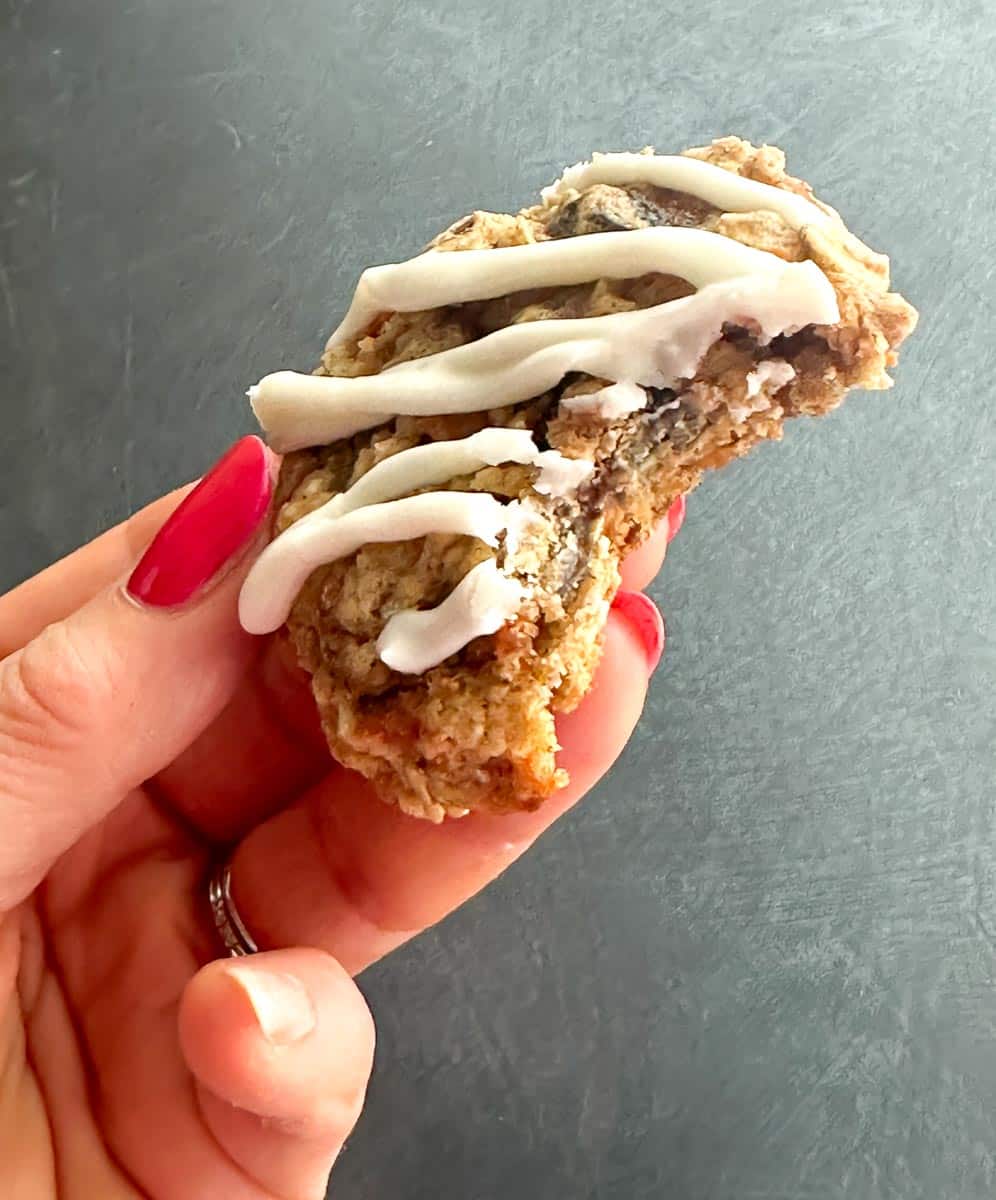
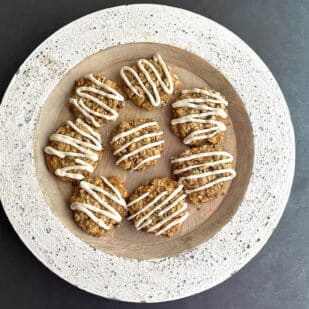
Low FODMAP Carrot Cake Oatmeal Cookies with Cream Cheese Drizzle
No need to decide between carrot cake and oatmeal cookies! These are an inspired mash-up of these two beloved classics. Super simple to make, too. The shredded carrots add color and moisture to what is a fairly traditional oatmeal cookie recipe. We have raisins and walnuts added, in addition to unsweetened coconut. Make sure to use unsweetened coconut, because sweetened will put the cookies way over the top in sweetness level.
Low FODMAP Serving Size Info: 24 cookies; 1 cookie per serving; 24 servings
Ingredients:
Cookies:
- 1 cup (145 g), minus 1 tablespoon low FODMAP, gluten-free all-purpose flour, such as Bob’s Red Mill 1 to 1 Gluten Free Baking Flour
- 1 teaspoon baking soda
- 1/2 teaspoon salt
- 1/4 cup (60 ml) coconut oil melted, cooled to room temperature
- 1/2 cup (107 g) firmly packed light brown sugar
- 1/4 cup(50 g) sugar
- 1 ½ teaspoons vanilla extract
- 1 ¼ teaspoons cinnamon
- 1 large egg, at room temperature
- 1 cup (110 g) shredded carrots
- 1 cup (99 g) old fashioned, rolled oats; use gluten-free if following a gluten-free diet
- 1/2 cup (48 g) unsweetened shredded coconut
- 1/2 cup (83 g) raisins
- ¼ cup (29 g) chopped, lightly toasted walnuts
Cream Cheese Drizzle:
- 2 tablespoons cream cheese, at room temperature and very soft
- 1 cup (90 g) sifted confectioners’ sugar
- 1 tablespoon lactose-free whole milk, or as needed
- 1/8 teaspoon vanilla extract
Preparation:
-
Position racks in upper and lower third of oven. Preheat the oven to 350°F (180°C). Line two half-sheet pans with parchment paper; set aside.
-
For the Cookies: In a small bowl, whisk together flour, baking soda, and salt; set aside.
-
In a large mixing bowl, whisk together the oil, sugars, vanilla, and cinnamon, then whisk in egg. Add the shredded carrots, oats, coconut, raisins and nuts, mixing until combined.
-
Slowly add flour mixture until cookie dough comes together. It will be thick; I use a combo of a wooden spoon and a large, sturdy silicone spatula throughout.
-
Drop cookie dough in golf-ball sized rounds, 2-inches (5 cm) apart, onto prepared pans. Bake for about 10 to12 minutes, rotating pans from one rack to the other, and front to back, halfway through baking time. Cookies should just be beginning to take on a golden hue, with the edges firmer than the centers; the centers can remain a tad soft. Cool cookies on pans on wire racks.
-
90 g While the cookies are cooling, place cream cheese, confectioners’ sugar, milk, and vanilla in a medium bowl. Beat vigorously with a wooden spoon, switching to a whisk, until super smooth and thick, but flowable. Add more milk if necessary. You can drizzle the mixture over the cookies using a fork or spoon, but I like to pipe out of a parchment cone. Allow drizzle to set for about 30 minutes; it will firm up. Cookies are ready to serve. Cookies may be stored in single layers, separated by parchment paper, in an airtight container at room temperature for up to 3 days.
Notes:
FODMAP Information
All recipes are based upon Monash University & FODMAP Friendly science at time of initial publication.
• Brown Sugar: Brown sugar has been lab tested by both Monash University and FODMAP Friendly. There are many kinds of brown sugar, from cane to beet (to blends) to Muscovado and more, which we discuss in our Explore An Ingredient: Sugar. Unfortunately, there is no information about what kind of brown sugars were lab tested. Monash gives us a low FODMAP amount of ¼ cup or 40 g but no further information. In addition, in private correspondence with Monash University we know that there are amounts larger than 40 g that would be considered low FODMAP. FODMAP Friendly gives us a low FODMAP amount of 13 g. Dark brown Muscovado sugar does appear in a product lab tested and certified low FODMAP by FODMAP Friendly, so we do know there is a low FODMAP amount.
• Carrots: Carrots have been lab tested and deemed low FODMAP by both Monash University and FODMAP Friendly. According to lab tests by both, carrots have shown no FODMAPs. Carrots were retested by Monash and their app entry is unclear. They state that carrots remain low FODMAP up to 500 g, which is a lot of carrot. But they do not give any information about what FODMAP(s) appear at that point in time.
• Coconut, dried: Dried coconut has been lab tested by both Monash University as well as FODMAP Friendly. Monash University lab testing sets a low FODMAP serving at ½ cup (30 g), with it becoming Moderate for FODMAPs at 45 g, and High at 50 g. FODMAP Friendly lab testing sets a low FODMAP serving at ¼ cup (25 g), with a max low FODMAP serve of 1 ¼ cups (125 g). We suggest that you use weights.
• Dairy: The low FODMAP diet is not a dairy-free diet. It is, however, low in lactose. Many dairy ingredients are low in lactose, such as heavy cream and many cheeses.
• Eggs: Eggs are high in protein and do not contain carbohydrates, according to Monash University.
• Oats: Both Monash and FODMAP Friendly have lab tested oats. FODMAP Friendly gave rolled oats a “Pass” at ½ cup or 43 g servings; in an update to the app, they report Quick Oats as low FODMAP at 47 g, or ½ cup uncooked. Their max low FODMAP serving is 59.53 g. Monash has several app entries and some are country specific. Here we present their “basic” app entries which are not country specific (use your app to look up the other entries). For their main entry called “rolled oats” they say a Green Light low FODMAP serving is ½ cup, which they peg at 52 g. For “quick oats” they state that a low FODMAP serving is only ¼ cup at 23 g, becoming moderate Yellow Light at ½ cup or 47 g.
• Oil: All pure oils are fats and contain no carbohydrates, therefore they contain no FODMAPs.
• Raisins: Monash and FODMAP Friendly have both lab tested raisins. While raw grapes contain no FODMAPs, the natural sugars concentrate upon drying and the resulting raisins do contain FODMAPs. Monash says a low FODMAP Green Light serving is 1 Australian tablespoon (13 g). FODMAP Friendly gives them a “Pass” at 3 tablespoons (30 g); they set a max serve at 13 tablespoons (130 g).
• Spices: Many fresh and dried spice have been lab tested by both Monash University and FODMAP Friendly and are easily looked up in the apps, which we strongly suggest that you have. The additional good news is that if you are interested in a spice that has not been lab tested, you can look at the nutritional panel and assess its FODMAP load for yourself. If the “Sugars” and/or “Carbs” are 1 g or less per serving, then the item would be a good bet to try.
• Sugar: Monash University and FODMAP Friendly have both lab tested white, granulated sugar. Monash states that a Green Light low FODMAP serving size of white sugar is ¼ cup (50 g). FODMAP Friendly simply states that they have tested 1 tablespoon and that it is low FODMAP. Regular granulated white sugar is sucrose, which is a disaccharide made up of equal parts glucose and fructose. Sucrose is broken down and absorbed efficiently in the small intestine. As the fructose is never in excess of the glucose, white sugar will never be high FODMAP, even in large amounts.
• Walnuts: Both Monash University and FODMAP Friendly have lab tested walnuts. FODMAP Friendly gives them a “Pass” at ¼ cup (30 g) portions. Monash lists the same gram amount as low FODMAP and pegs the volume at 10 walnut halves.
Please always refer to the Monash University & FODMAP Friendly smartphone apps for the most up-to-date lab tested information. Foods will be retested from time to time; in the case of raw ingredients, such as fruits and vegetables, results may vary. All lab tested results are valid and represent a snapshot in time. As always, your tolerance is what counts; please eat accordingly. The ultimate goal of the low FODMAP diet is to eat as broadly as possible, without triggering symptoms, for the healthiest microbiome.
Nutrition
All nutritional information is based on third-party calculations and should be considered estimates. Actual nutritional content will vary with brands used, measuring methods, portion sizes and more. For a more detailed explanation, please read our article Understanding The Nutrition Panel Within Our Recipes.
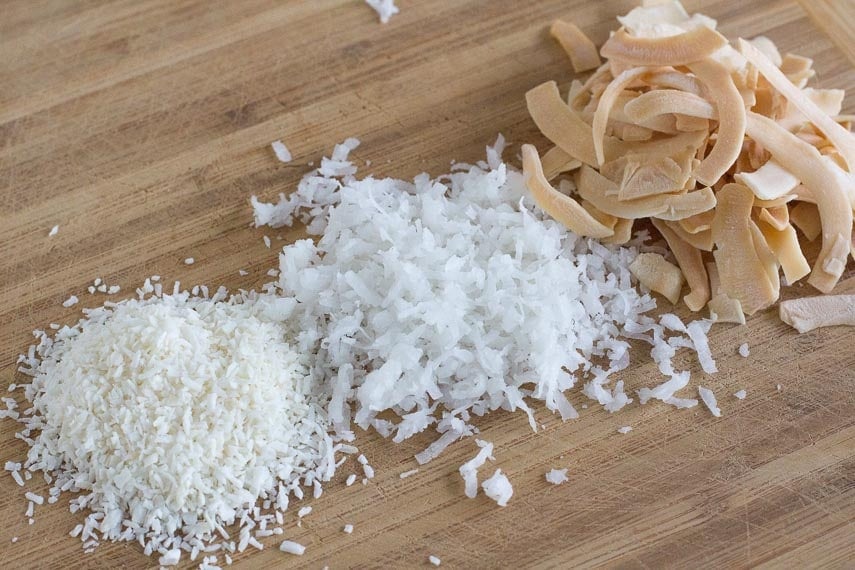
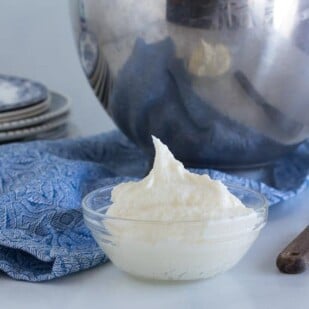







I was about to make the frosting when I noticed that my Lactose free cream cheese had gone bad. I then tasted the cookies and they were plenty sweet as is so I decided to leave them alone. Since coconut oil is one of the least healthy oils (I realize this is a dessert), I used canola oil. I will definitely make these again. Yum.
So funny you make the comment about the coconut oil. I am SOOOOO anti coconut oil in my regular cooking. I cannot stand it. Here, the unrefined as coconut flavor, so that is why I used it. So happy you made these!